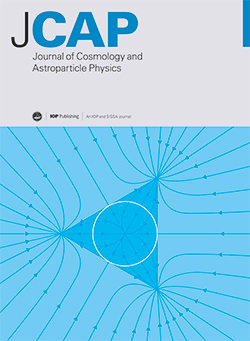A natural explanation of the VPOS from multistate Scalar Field Dark Matter
IF 5.3
2区 物理与天体物理
Q1 ASTRONOMY & ASTROPHYSICS
Journal of Cosmology and Astroparticle Physics
Pub Date : 2025-01-31
DOI:10.1088/1475-7516/2025/01/155
引用次数: 0
Abstract
Observations with the Gaia satellite have confirmed that the satellite galaxies of the Milky Way are not distributed as homogeneously as expected. The same occurs in galaxies such as Andromeda and Centaurus A, where satellites around their host galaxies have been observed to have orbits aligned perpendicular to the galactic plane of the host galaxy. This problem is known for the Milky Way as Vast Polar Structure (VPOS). The Scalar Field Dark Matter Field (SFDM), also known as Ultralight-, Fuzzy-, BEC-, and Axion-dark matter, proposes dark matter is a scalar field, which in the non-relativistic limit follows the Schrödinger equation coupled to the Poisson equation. Although the SF here is classical, the Schrödinger equation contains a ground and excited states as part of its nature. In this work, we show that such quantum character of the SFDM can naturally explain the VPOS observed in galaxies. By taking into account the finite temperature corrections for a complex, self-interacting SF at very early epochs of the Universe, we show that with the ground and first excited states in the Newtonian limit, we can fit the rotation curves of the host galaxies. With the best-fit parameters obtained, we can explain the VPOS. We do this with particular galaxies, such as the Milky Way, Andromeda, Centaurus A, and 6 other galaxies whose satellites have been observed. This result shows that the multistate SFDM is not distributed homogeneously around the galaxy, and therefore might explain the anisotropic distribution of the satellite galaxies. According to this result, this could be a general characteristic of the galaxies in the Universe. Finally, we also show how the scale of each galaxy depends on a parameter determined by the final temperature of the SF galactic halo under study. This might explain why different galaxies with SFDM give different values of the mass of the SF.求助全文
约1分钟内获得全文
求助全文
来源期刊

Journal of Cosmology and Astroparticle Physics
地学天文-天文与天体物理
CiteScore
10.20
自引率
23.40%
发文量
632
审稿时长
1 months
期刊介绍:
Journal of Cosmology and Astroparticle Physics (JCAP) encompasses theoretical, observational and experimental areas as well as computation and simulation. The journal covers the latest developments in the theory of all fundamental interactions and their cosmological implications (e.g. M-theory and cosmology, brane cosmology). JCAP''s coverage also includes topics such as formation, dynamics and clustering of galaxies, pre-galactic star formation, x-ray astronomy, radio astronomy, gravitational lensing, active galactic nuclei, intergalactic and interstellar matter.
 求助内容:
求助内容: 应助结果提醒方式:
应助结果提醒方式:


